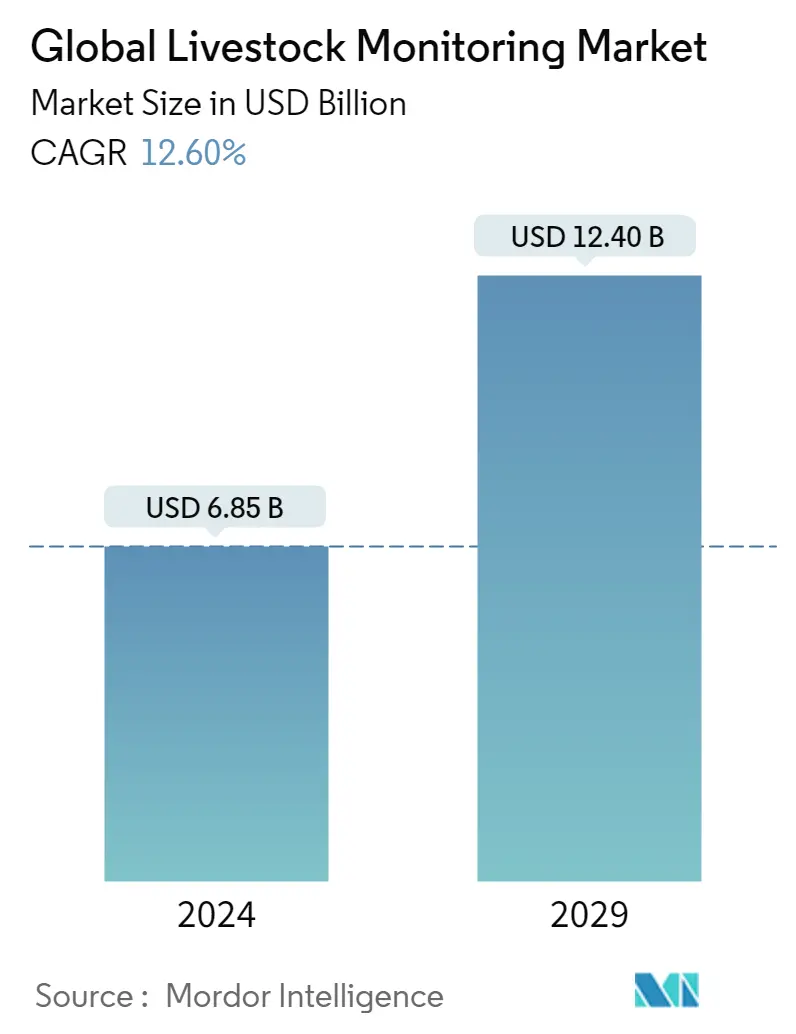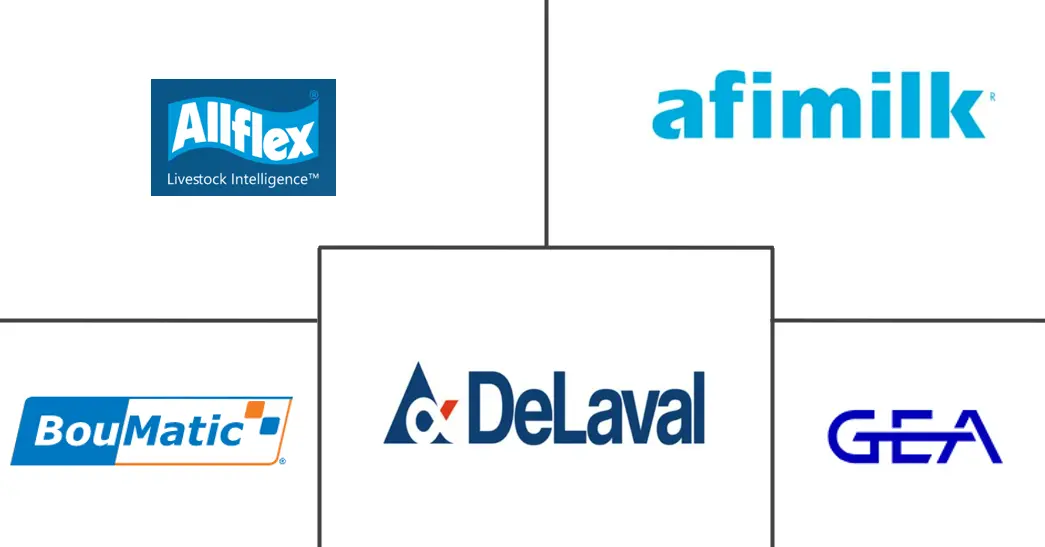Market Size of Global Livestock Monitoring Industry

| Study Period | 2019 - 2029 |
| Market Size (2024) | USD 6.85 Billion |
| Market Size (2029) | USD 12.40 Billion |
| CAGR (2024 - 2029) | 12.60 % |
| Fastest Growing Market | Asia-Pacific |
| Largest Market | North America |
Major Players
*Disclaimer: Major Players sorted in no particular order |
Livestock Monitoring Market Analysis
The Global Livestock Monitoring Market size is estimated at USD 6.85 billion in 2024, and is expected to reach USD 12.40 billion by 2029, growing at a CAGR of 12.60% during the forecast period (2024-2029).
COVID-19 has majorly impacted the livestock industry as well as the production industries. The restrictions imposed by the government to control the spread of COVID-19 among the nation have had a significant impact on the livestock industry, interrupting the supply chain for animal feed, lowering animal husbandry services, and limiting animal health services including delays in illness detection and treatment. For instance, According to the National Center for Biotechnology Center, 2020, with the incidence of COVID-19, the dairy industry in India has suffered significantly due to the reduced overall demand of about 25-30% in the country, at least during the first one month after the lockdown, that is, since March 25, 2020. In addition, to control the spread of coronavirus, the government has sealed the borders to restrict vehicle mobility which further hampered the transfer of milk to customers in the border regions.
The market's expansion can be ascribed to an increase in the cow population, increased incidences of zoonotic diseases, as well as the increasing adoption of livestock monitoring technologies, as there is substantial cost-saving associated with livestock monitoring management. The livestock population has been increasing over the past few decades globally. For instance, India, Brazil, and China accounted for over 65% of the global cattle inventory in 2021. In addition, animal monitoring devices have become more common in industrialized nations, allowing for real-time monitoring of livestock. Some of the primary drivers driving market expansion include a growing focus on real-time monitoring and early illness diagnosis, expanding usage of IoT and AI for livestock monitoring, and rising worldwide demand for meat. For instance, In October 2021, Allflex Livestock Intelligence launched an enhanced version of its intelligent SenseHub monitoring ear tag, which will have a multi-function LED to aid in the detection of individual animals in a group environment. It keeps track of delicate fertility and rumination behavioral patterns in dairy and beef cattle of all ages to determine whether they are in heat or require additional care or treatment.
Furthermore, fierce competition among market participants, with a strong focus on product lines and innovations, is influencing the future of livestock management. For instance, in March 2020, the United States-based CattleEye introduced an AI-backed livestock management platform. Users with this platform would be able to identify cows and living conditions of their health, feed, and environment to improve productivity.
- However, the high cost of livestock monitoring solutions, as well as a lack of skills and knowledge of technology among farmers, are likely to stifle market expansion.
Livestock Monitoring Industry Segmentation
As per the scope of the report, livestock monitoring is the process of collection of data to serve the purpose of alerting the farmers to observe the live condition of the livestock environment. This type of monitoring system keeps track of the animal's healthy nutrition, reproduction, and overall well-being in real-time. The Global Livestock Monitoring Market is segmented by animal type (Cattle, Poultry, Equine, and Others), Component (Hardware, Software, and Services), application (Feeding Management, Milk Harvesting, Breeding Management, and Others), and geography (North America, Europe, Asia-Pacific, Middle-East and Africa, and South America). The report offers the value (in USD million) for the above segments. The market report also covers the estimated market sizes and trends for 17 countries across major regions globally.
| By Livestock Type | |
| Cattle | |
| Poultry | |
| Swine | |
| Others |
| By Component | |
| Devices | |
| Services and Software |
| By Application | |
| Milk Harvesting | |
| Breeding Management | |
| Feeding Managemnet | |
| Others |
| Geography | ||||||||
| ||||||||
| ||||||||
| ||||||||
| ||||||||
|
Global Livestock Monitoring Market Size Summary
The livestock monitoring market is poised for significant growth, driven by the increasing adoption of advanced technologies such as IoT and AI, which facilitate real-time monitoring and early illness diagnosis in livestock. The market's expansion is further supported by a rising global demand for meat and a growing focus on cost-saving measures associated with livestock management. Despite the challenges posed by the COVID-19 pandemic, which disrupted supply chains and limited animal health services, the market has shown resilience. The increasing cow population and the prevalence of zoonotic diseases have also contributed to the demand for effective monitoring solutions. Companies are actively innovating and expanding their product lines to meet the evolving needs of the industry, with notable advancements in monitoring devices and platforms.
North America is expected to hold a significant share of the livestock monitoring market, attributed to its high technological advancements and substantial consumption of poultry products. The region's market growth is further bolstered by the prevalence of zoonotic diseases, which necessitate the monitoring of animal health. The competitive landscape of the global livestock monitoring market is characterized by the presence of numerous players focusing on innovation, cost reduction, and sustainability. Key companies are developing advanced monitoring systems and collaborating with other firms to enhance their offerings. Despite the high costs and technological knowledge gaps among some farmers, the market continues to grow, supported by government initiatives and training programs aimed at improving livestock care and productivity.
Global Livestock Monitoring Market Size - Table of Contents
-
1. MARKET DYNAMICS
-
1.1 Market Overview
-
1.2 Market Drivers
-
1.2.1 Increasing Prevalence of Major Animal Diseases
-
1.2.2 Increasing Focus on Real-time Monitoring and Early Disease Detection
-
-
1.3 Market Restraints
-
1.3.1 High Cost of Livestock Monitoring Solutions
-
1.3.2 Lack of Understanding of Technology Among Farmers
-
-
1.4 Porter's Five Forces Analysis
-
1.4.1 Threat of New Entrants
-
1.4.2 Bargaining Power of Buyers/Consumers
-
1.4.3 Bargaining Power of Suppliers
-
1.4.4 Threat of Substitute Products
-
1.4.5 Intensity of Competitive Rivalry
-
-
-
2. MARKET SEGMENTATION
-
2.1 By Livestock Type
-
2.1.1 Cattle
-
2.1.2 Poultry
-
2.1.3 Swine
-
2.1.4 Others
-
-
2.2 By Component
-
2.2.1 Devices
-
2.2.2 Services and Software
-
-
2.3 By Application
-
2.3.1 Milk Harvesting
-
2.3.2 Breeding Management
-
2.3.3 Feeding Managemnet
-
2.3.4 Others
-
-
2.4 Geography
-
2.4.1 North America
-
2.4.1.1 United States
-
2.4.1.2 Canada
-
2.4.1.3 Mexico
-
-
2.4.2 Europe
-
2.4.2.1 Germany
-
2.4.2.2 United Kingdom
-
2.4.2.3 France
-
2.4.2.4 Italy
-
2.4.2.5 Spain
-
2.4.2.6 Rest of Europe
-
-
2.4.3 Asia-Pacific
-
2.4.3.1 China
-
2.4.3.2 Japan
-
2.4.3.3 India
-
2.4.3.4 Australia
-
2.4.3.5 South Korea
-
2.4.3.6 Rest of Asia-Pacific
-
-
2.4.4 Middle-East and Africa
-
2.4.4.1 GCC
-
2.4.4.2 South Africa
-
2.4.4.3 Rest of Middle-East and Africa
-
-
2.4.5 South America
-
2.4.5.1 Brazil
-
2.4.5.2 Argentina
-
2.4.5.3 Rest of South America
-
-
-
Global Livestock Monitoring Market Size FAQs
How big is the Global Livestock Monitoring Market?
The Global Livestock Monitoring Market size is expected to reach USD 6.85 billion in 2024 and grow at a CAGR of 12.60% to reach USD 12.40 billion by 2029.
What is the current Global Livestock Monitoring Market size?
In 2024, the Global Livestock Monitoring Market size is expected to reach USD 6.85 billion.

